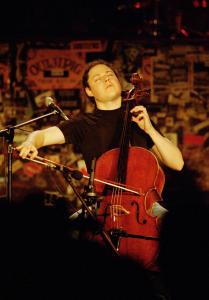tuesday 2004 oct 12

was honored to
host
 MATT HAIMOVITZ
MATT HAIMOVITZlive
in concert, one night only,
coming through Bartlesville on
his
50-state Anthem tour.
He played one great long set of
classical and contemporary composers. Pictures allegedly forthcoming.
MATT
HAIMOVITZ'S
50-STATE ANTHEM
TOURCellist Matt Haimovitz has established himself as one of
classical music's most adventurous artists, equally at ease playing the
masterworks for his instrument in solo, chamber and concerto performances in
leading concert halls as he is bringing classical music to new listeners in
surprising new venues.
Haimovitz has been "busily reinventing the
classical recital for the new millennium," commencing his 50-state "Anthem"
tour on September 11, 2003 in celebration of living American composers. The
performances have received universal praise, and the "Anthem" album has
appeared on numerous top 10 lists, including the Best classical Album of 2003
on Amazon.com. In 2004, the American Music Center has awarded Haimovitz one of
its highest distinctions, the Trailblazer Award, for his far-reaching
contribution to American music. Prior to the "Anthem" tour, Haimovitz made
headlines with his path-breaking performances of Bach's 6 Suites for Cello
Solo. He struck a nerve in the music world with his innovative Bach
"Listening-Room" Tour, taking Bach's beloved cello suites out of the concert
hall and performing them in intimate clubs and coffeehouses across the U.S.,
Canada, and the U.K., to great acclaim. ...
Complete article at
Oxingale.com
![[*]](../../../main/new-window.png) Read about the ANTHEM
CD
Read about the ANTHEM
CD ![[*]](../../../main/new-window.png)
The Hyperstring Trilogy (from Tod Machover's program notes for
the Lincoln Center Premiere)
With Joe Chung, I had started the development
of Hyperinstruments at the MIT Media Lab in 1986, for the purpose of enhancing
and expanding performance virtuosity through technology. Partly motivated by
the negative example of sophisticated digital studio recording that risked
taking the spontaneity and intuition out of music-making, we sought to develop
techniques that would allow the performer's normal playing technique and
interpretive skills to shape and control computer extensions to the instrument,
thus combining the warmth and "personality" of human performance with the
precision and clarity of digital technology. In fact, the whole hyperinstrument
idea is an extension of my general musical philosophy: to convey complex
experience in a simple and direct way.
Photo of
Hypercello
TOD MACHOVER was less lucky with technology. Hypercellist — and
supercellist — Matt Heimovitz’s plane arrived late from
London, so the beginning of the hypertrilogy was delayed to give him some
breathing space. After a brief demonstration, Begin Again Again . . . , the
Inferno of Machover’s Divine Comedy, began. But suddenly Heimovitz was
playing solo — that is, the computers weren’t producing the marvelous
electronic textures generated by the sensors on his bow and by an electronic
glove on his bowing hand (all the music, including the electronic augmentation,
is live). “It doesn’t have this title for nothing,” Machover
joked, and so after a short break to reboot (he called these old Macs
“historical instrument computers”), Begin Again Again . . . began
again.
READ
ARTICLE
JIMI
HENDRIX'S
STAR-SPANGLED BANNER
AT WOODSTOCKBy the third
morning of the original Woodstock music festival, attendees had endured crowds
and gridlock and storms. Many were becoming aware they were making history, but
they were probably mostly just kind of cold and hungover by that third
morning.
Onstage in the dawning light, a rising new pop star, a hippy-
trippy-looking black dude who had made his mark earlier performing in Europe,
and then at the Monterey Pop Festival, playing electric guitar like no one had
ever done before. That morning at Woodstock, folks were awakened in grand
tradition with the Star-Spangled Banner, but performed as none had ever heard
it, nor even imagined it being performed.
This music festival came
amidst a time of social chaos, an America divided across lines of politics,
race, and war, fights and divisions against which Woodstock itself became a
symbol of peace and unity. Suddenly cutting through the landscape came this
rousing rock reville, stirring those deep-rooted patriotic thrills and filled
with all the freedom-loving, loud, extreme power of amplified rock. With
screaming strings and whining feedback, Jimi Hendrix created an anthem so
powerful you could hear the rockets, the bombs bursting in air, a Star-Spangled
Banner that would make the hard-hearted anarchist rock fan stand up and
salute.
Hendrix's Star-Spangled Banner has become a classic of rock.
Moments such as this remarkable Woodstock performance of the American anthem
re-shaped our thinking in those years, and such thinking expands to profoundly
affect generations to come. Young teenagers today, whose parents were infants
when Hendrix was alive, hole up in their bedrooms repeatedly playing an MP3 of
that long-ago guitar solo, trying to emulate his licks. We've enjoyed a few
performers' attempts at re-creating Hendrix's version on our stage here at
us75.com/. Even performed with less-than-Hendrix flair, it's evocative, joyous,
as unrestrained as American ideals of liberty.
One day, on NPRadio, we
heard Matt Haimovitz perform his version of Jimi Hendrix's incredible
electrified amplified national anthem... on an acoustic cello. I thought, Jimi
would have been impressed. I know I was.
Tuesday should be a great show.
Hope you can join us. :D
Jimi-Hendrix.com
![[*]](../../../main/new-window.png) Live at Woodstock 35th Anniv. CD
Live at Woodstock 35th Anniv. CD
![[*]](../../../main/new-window.png)
 MATT HAIMOVITZ
MATT HAIMOVITZ